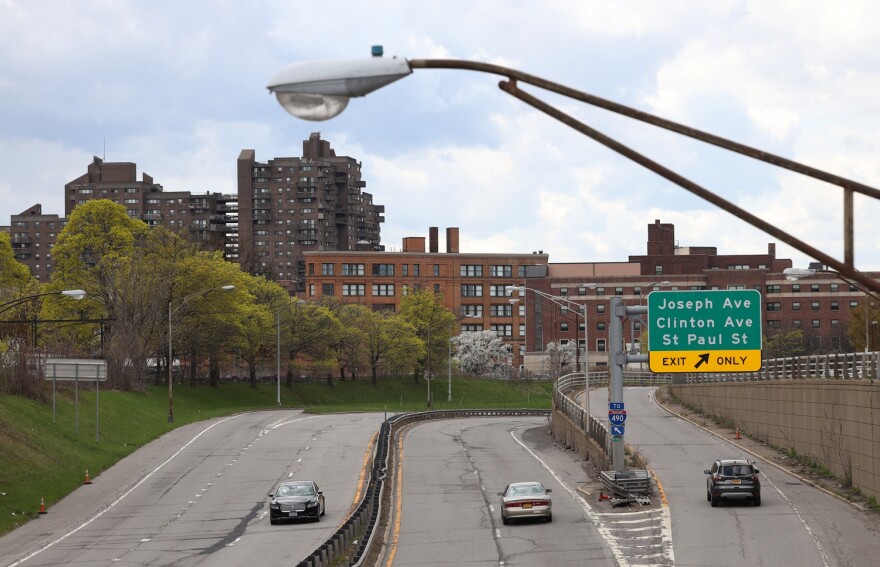The removal of Rochester’s northern Inner Loop promises to be transformative for the city.
But when U.S. Sen. Kirsten Gillibrand visited Monday to tout what could be the largest federal infrastructure project ever in Rochester, the focus wasn’t so much on the construction project.
Rather, it was on whether the investment would deliver in a lasting way for those living in the neighborhoods long ago severed by the sunken highway.
It was about jobs.
And the senator’s promise that local people would be doing the work.
These assurances have been made before -- on the downtown soccer stadium and on the multimillion-dollar school modernization project, for example. But critics have said many of the workers on those projects came from outside the city.
“I mean, you have a beautiful new gym, great new library. But what does that do for the community?” asked Kereem Berry, executive director of the Multi-Craft Apprenticeship Preparation Program. “The parents are still in the same economic position. What are we doing? Nothing has changed.”
The program works to prepare people from historically disadvantaged communities for jobs in the construction and building trades.
Berry urged Gillibrand to go beyond local labor provisions included in the federal legislation to specify city ZIP codes in hiring.

Much of the area around the northern Inner Loop has higher poverty, higher unemployment and lower wages than the city as a whole.
“I know when they say local labor, that does not mean specifically the area that you are working in,” Berry said. “More so the jurisdiction of that particular trade, that particular union.”
And that can stretch across multiple counties.
Study anticipates housing boom
Rochester wants to replace the Inner Loop stretch between East Main Street and Interstate 490 with an at-grade boulevard, reconnecting neighborhoods along the edge of downtown and opening acres for new development and restored green space.
The scope of this project is massive.
Inner Loop North encompasses 1.5 miles of roadway (Inner Loop East was two-thirds of a mile), 10 bridges (the eastern section removed three) and 7,000 feet of retaining walls.
A recent study projected strong housing demand, largely multi-family, primarily for renters – mirroring Inner Loop East.
That would run counter to the wishes of residents, who have pushed for single-family and owner-occupied housing rather than big apartment buildings.

The study breaks down the market into segments, with the strongest for housing and office being south of the current Inner Loop and closest to downtown. Single-family detached and townhouses are seen as most likely to come through infill or redevelopment of existing housing.
Expectations are to begin tearing out the sunken highway in 2026.
The study projects a flood of new housing by 2040, including hundreds more apartments – which would increase the already large share of rental housing in the area. Coupled with new townhouses and in-fill single-family homes, the total housing stock in the immediate area could increase by 50%.
Office demand also is thought to be considerable, despite a largely vacant Kodak Tower positioned on the west edge of the study area.
Holding to the promise
Lifting up these neighborhoods has been a focus of project planning from the start.
But community leaders' promises were tempered Monday with the recognition that this remains very much a work in process, and an understanding that the proof will not be in the planning but in the doing.
That seemed to impress Mitch Landrieu, who serves as White House infrastructure coordinator and a special adviser to President Joseph Biden.
“I think this is going to be one of the best projects in the country,” he said.
Landrieu joined Gillibrand in a tour of upstate cities highlighting federal infrastructure investments. Before Rochester, he was in Syracuse, where he reportedly offered similar praise for its much larger highway rebuild involving a stretch of Interstate 81.

“I saw really great stuff today,” he said. “I mean, what I like about what I've seen is the cohesion in the communities and the fact that the community has come together with a plan.”
He and Gillibrand met with other dignitaries in the basement of Prayer House Church of God by Faith, which sits on Cumberland Street overlooking the Inner Loop.
Deacon Hollie Williams sat in the back, recording.
“We think we can hold them to the promise, and we got it recorded,” he said with a smile. “This is what they said. And we intend to hold them to that.”
The project is just moving into design with construction still several years off. But that gives time, officials said, to prepare a neighborhood workforce.









